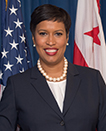Washington, DC
Mayor Bowser Urges Residents to Follow Recommendations Related to the Code Red Air Quality Alert
(Washington, DC) –The Metropolitan Washington Council of Governments and District Department of Energy and Environment (DOEE) issued a “Code Red” air quality alert for Washington, DC on Wednesday, June 7 and Thursday, June 8. In response, Mayor Muriel Bowser and District officials from DOEE, the DC Homeland Security and Emergency Management Agency, and the Department of Health (DC Health) are urging residents and visitors to follow precautions related to the “Code Red” air quality alert.
Smoke from Canadian wildfires is causing unhealthy air quality in the Washington, DC area and the northeast United States, and this problem is likely to continue or worsen through Friday. DC Health and DOEE recommend that residents pay attention to local air quality reports and the US Air Quality Index at airnow.gov.
When the Air Quality Index is above 150 in your area (Code Red), District residents are recommended to:
- Avoid exercising and other strenuous activities outdoors.
- Older adults (over age 65), children, pregnant women, and those who have heart disease, asthma, or other chronic lung disease, should stay indoors as much as possible. Keep windows and doors closed. Run an air conditioner if you have one, but keep the fresh-air intake closed and the filter clean to prevent outdoor smoke from getting inside.
- Use an air filter. Use a freestanding indoor air filter with particle removal. Follow the manufacturer’s instructions on filter replacement and where to place the device.
- If you are vulnerable because of age or medical conditions and must be outdoors, consider wearing a tight-fitting N95 or KN95 mask. Paper “comfort” or “dust” masks commonly found at hardware stores or ordinary cloth masks will not protect your lungs from smoke. However, a tightly-fitting “N95” mask or “KN95 mask” will offer some protection. See the Respirator Fact Sheet provided by the Centers for Disease Control and Prevention’s National Institute for Occupational Safety and Health.
- If you have asthma, chronic lung disease, or heart disease, follow your doctor’s advice about medicines. Call your doctor if you have difficulty breathing or worsening symptoms.
When the Air Quality Index is above 200 in your area (Code Purple or Maroon), all groups should stay indoors as much as possible. Those who must work outside should reduce work outside if possible, and if not, wear a mask (N95 or KN95 equivalent).
When the Air Quality Index is between 100 and 150 in your area (Code Orange), follow these tips:
- Older adults (over age 65), children, pregnant women, and those who have heart disease, asthma or other chronic lung disease, should avoid exercising outdoors.
- If you have asthma, chronic lung disease, or heart disease, follow your doctor’s advice about medicines. Call your doctor if your symptoms worsen.

U.S. Air Quality chart according to the U.S. Environmental Protection Agency index.
Other tips that residents should follow while the air quality remains unhealthy:
- Avoid long or intense outdoor activities
- Consider rescheduling or moving activities indoors
- Consider wearing a high-quality mask (N95 or K95) outdoors
- Keep doors and windows closed
Find additional recommendations from the U.S Environmental Protection Agency.
Shelter Hotline and Emergency Shelter
Individuals should call the Shelter Hotline (202) 399-7093 to request transportation to shelter for unsheltered residents. Low-barrier shelters remain open 24 hours and are ready to receive residents who need relief from poor outdoor air quality. District and partner agency outreach teams are informing unsheltered residents to seek relief from poor outdoor air quality in shelters and service centers.
- Adams Place Day Center (2210 Adams Place NE), 7:00 am -7:00 pm
- Downtown Day Services Center (1313 New York Avenue NW), normal hours are 9:00 a.m.-5:00 p.m., but the center will remain open until 7:00 pm on Wednesday, June 7 and Thursday, June 8
- 801 East Day Center Day Center (2722 Martin Luther King Jr. Avenue SE), 9:00 am.-5:00 pm
Parks and Recreation Centers
While air quality remains in “Code Red,” the Department of Parks and Recreation (DPR) has canceled all DPR-led youth outdoor programs and events. DPR sites remain open.
DC Public Schools
While air quality remains in “Code Red,” all DC Public Schools’ outdoor activities are canceled. This includes recess, outdoor Physical Education classes, athletic practices and competitions, and any school-specific events or field trips intended for the outdoors.
Please call 311 if you have any questions or concerns about the air quality alert in the District. Please do not call 911 unless you are experiencing an emergency or immediate safety risks.
Continue to monitor airnow.gov for the latest information on air quality.

